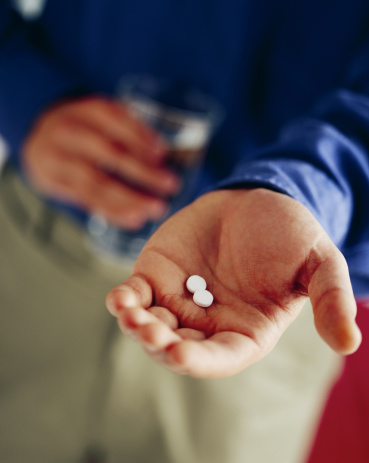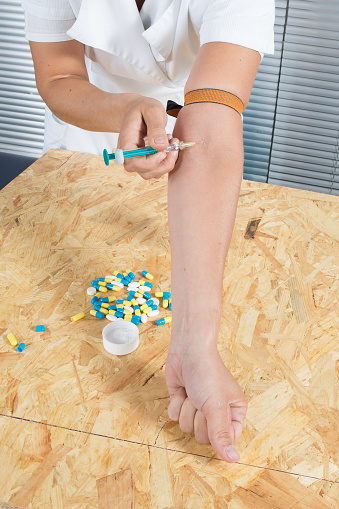The rate of pain medication prescription in the United States is at an all-time high right now, and unfortunately the sheer volume of addictive painkillers available means many people “intentionally or otherwise” are becoming dependent on these drugs. Prescription drugs such as Demerol, Dilaudid, Vicodin and OxyContin (and many others) can be extremely addictive, particularly due to their being opioids and being derived from the same plant as heroin.
According to the Centers for Disease Control and Prevention (CDC), 44 people die every day from an overdose of prescription painkillers. It also reported that nearly two million Americans abused painkillers every day in 2013 and almost 7,000 people per day are treated in emergency rooms for misusing prescriptions as directed.[1]
While opioid prescriptions are often necessary to help manage pain and function normally, nine out of 10 U.S. doctors surveyed by US News & World Report in 2014 believed prescription opioid abuse was a moderate to large problem in their community, with 85 percent believing these drugs were being overprescribed.[2]
More Painkiller Abuse Statistics
- 5 percent of the U.S. population consumes 75 percent of the world’s prescription drug supply. Misuse of painkillers represents 75 percent of the overall problem of prescription drug abuse.[3]
- In 2012, 259 million opioid pain medication prescriptions were written; enough for every adult in America to get a bottle of pills. Every day, 2,500 American youths abuse a prescription pain reliever for the first time.[4]
- 52 million Americans over age 12 have used prescription drugs non-medically in their lifetime. 54.2 percent of all prescription drugs are obtained for free from a friend or family member.[5]
Detecting Opioid Dependence and Addiction
Many individuals who have developed a dependence on prescription painkillers have done so because they were prescribed drugs to treat chronic pain or pain from a recent accident, surgery or something else resulting in debilitating pain. This is one of the reasons why it is particularly difficult to determine whether a person’s painkiller use is healthy or not. Since we can’t step into someone’s body and feel the pain they’re feeling, it’s impossible to know how much they truly need the pills and how much of their need is based on a problematic dependence.
Nearly two million Americans abused painkillers every day in 2013 and almost 7,000 people per day are treated in emergency rooms for misusing prescriptions as directed.
One of the problems with long-term prescription use is that it often leads to tolerance and dependence. As people continue to use prescription opioids to alleviate pain over extended periods of time, their bodies develop tolerance where more and more of the drug is needed for pain relief. This cycle can continue until a person is dependent on the drug for daily functioning and relief. Chronic opioid use can also lead to hyperalgesia, a condition which causes reduced pain tolerance and increased sensitivity to pain. This condition may also cause individuals to falsely believe they need more pain medication.[6]
Addiction to pain medication is not always as obvious as addiction to more illegal substances, but being aware of the symptoms can make all the difference when it comes to treating someone suffering from an addiction.
Some of the most common symptoms and side effects from pain medication addiction are:
- Requests for higher doses of specific drugs
- Refusal for needed drug changes
- Early or unscheduled requests for drug refills
- Coming up with excuses for a prescription refill
- Late-night or late-week ER visits for more pain medication
- Seeking multiple doctors for prescriptions, called “doctor shopping”
- Buying medication from places other than pharmacies
- Asking friends or relatives for medication
- Avoiding family and friends
- Unwillingness to try other therapies for pain treatment
- Doesn’t want to participate in drug testing
- Neglecting responsibilities
- Odd, sudden, or negative changes in mood or behavior
- Pupils that are consistently large or small
- Track marks or bruises from needles
- Difficulty talking or walking
- Excessive tiredness or anxiety
- Claiming pain when there is no physical appearance of suffering
- Onset of depression
- Respiratory trouble
- Intestinal trouble
- Heart failure
- Liver trouble
Gateway to Heroin Addiction
 An increase in monitoring of prescription drugs and crackdowns on pill mills throughout the nation has begun to reduce the amount of people abusing prescription opioids and overdosing on them. However, this change has led to the unintended consequence of increased heroin abuse and overdoses. Stronger restrictions on prescription pills have not reduced addiction; it has just made addicts turn to heroin instead. Heroin gives addicts a cheaper and potentially more potent option that does not require a prescription.[7]
An increase in monitoring of prescription drugs and crackdowns on pill mills throughout the nation has begun to reduce the amount of people abusing prescription opioids and overdosing on them. However, this change has led to the unintended consequence of increased heroin abuse and overdoses. Stronger restrictions on prescription pills have not reduced addiction; it has just made addicts turn to heroin instead. Heroin gives addicts a cheaper and potentially more potent option that does not require a prescription.[7]
The CDC claims that opioid prescribing has primed Americans for heroin addiction. Both drugs work on the same brain receptors and cause similar feelings of euphoria and relaxation. In 2013, there were 8,257 overdoses from heroin, which is nearly four times the amount from 2006. The organization also reported that people who abuse or are dependent on prescription opioids are 40 times more likely to also abuse or be dependent on heroin.[8]
Heroin and opioid addiction has been called a full blown national health crisis and one of the largest epidemics in American history.[9]
What Can Be Done?
When attempting to combat any addiction threat in society, education is the most effective tool. Many local, state and federal authorities and health organizations have launched awareness campaigns to educate children, parents and educators about the warning signs of abuse and addiction. Pharmaceutical companies have also taken steps to reformulate certain drugs to make them more difficult to abuse.
There’s also a call for doctors and other healthcare professionals to look at drug-free pain management options instead of automatically prescribing prescription drugs for all pain. However, with the average doctor visit lasting about 15 minutes (meaning actual time speaking with the doctor), prescribing drugs is often the quickest and easiest solution to a patient’s pain issues.[10]
It’s important for parents to be aware of medications in bathroom medicine cabinets and other areas where children and others can obtain prescription drugs for personal use. It’s also important for parents to look for signs of drug abuse and addiction, especially those with children ages 12 and up.
Please download Behavioral Health of the Palm Beaches’ free informational ebook, Understanding Addiction to Pain Medication. In it you will find information on the physiological and mental effects of pain medication addiction, as well as recommendations for selecting a detox and recovery program for yourself or for someone close to you who is struggling with addiction.



